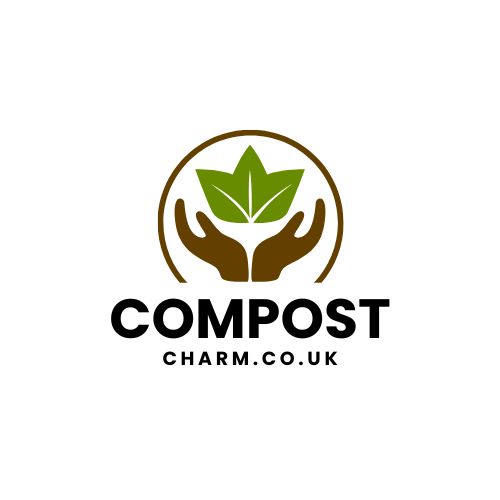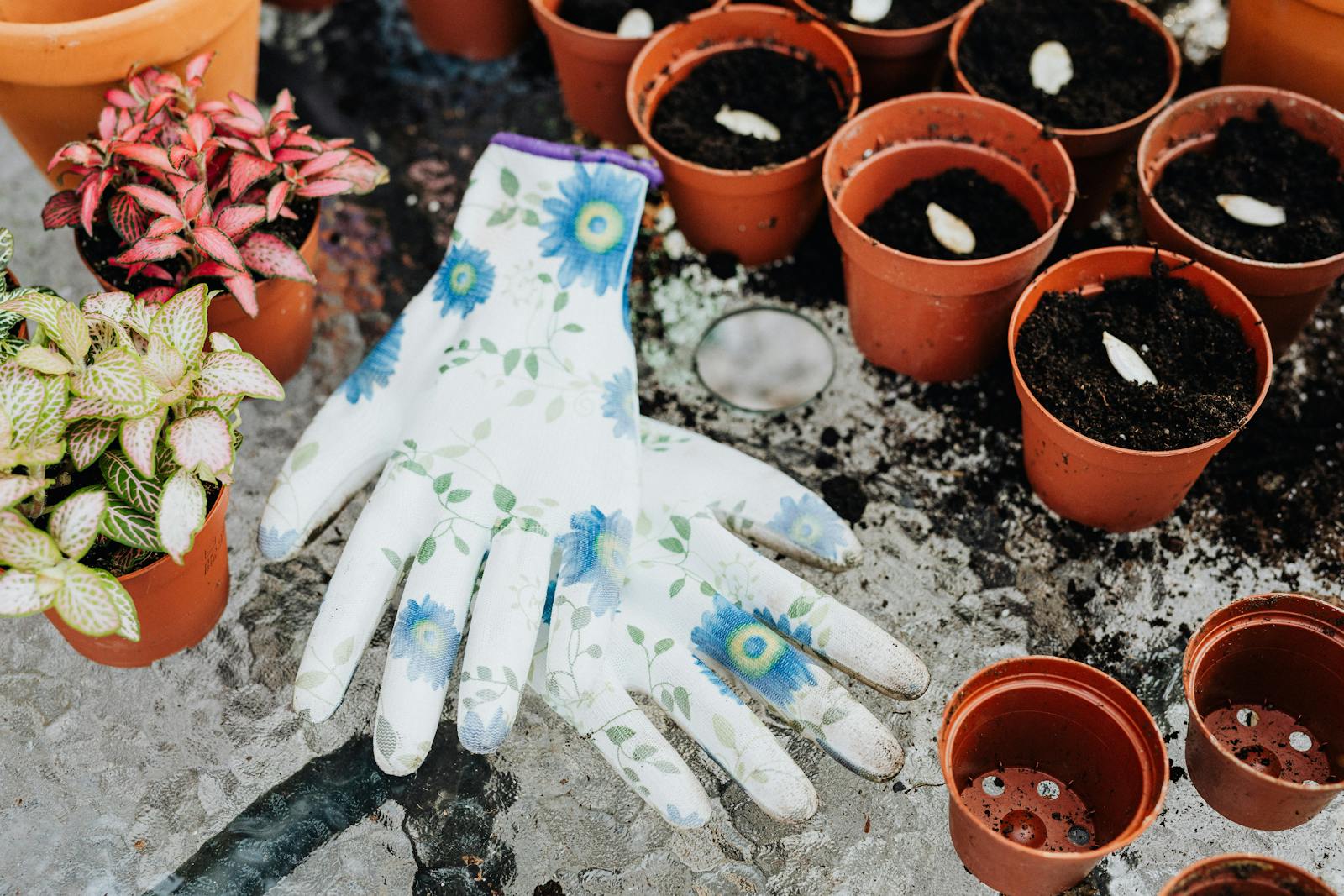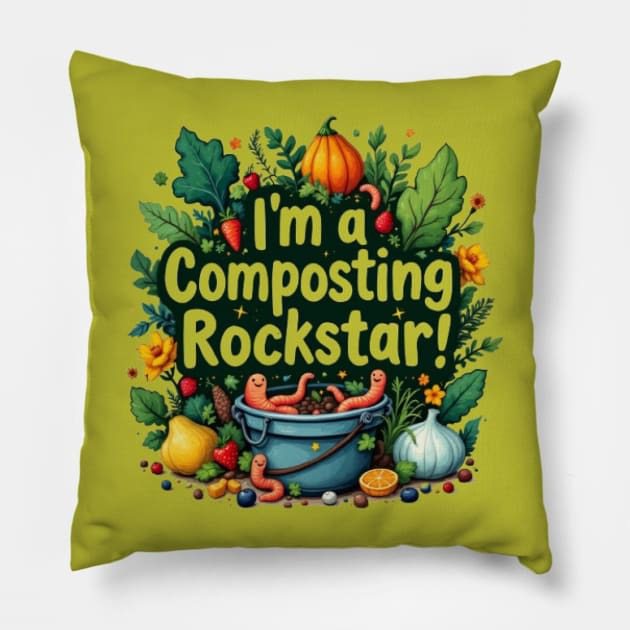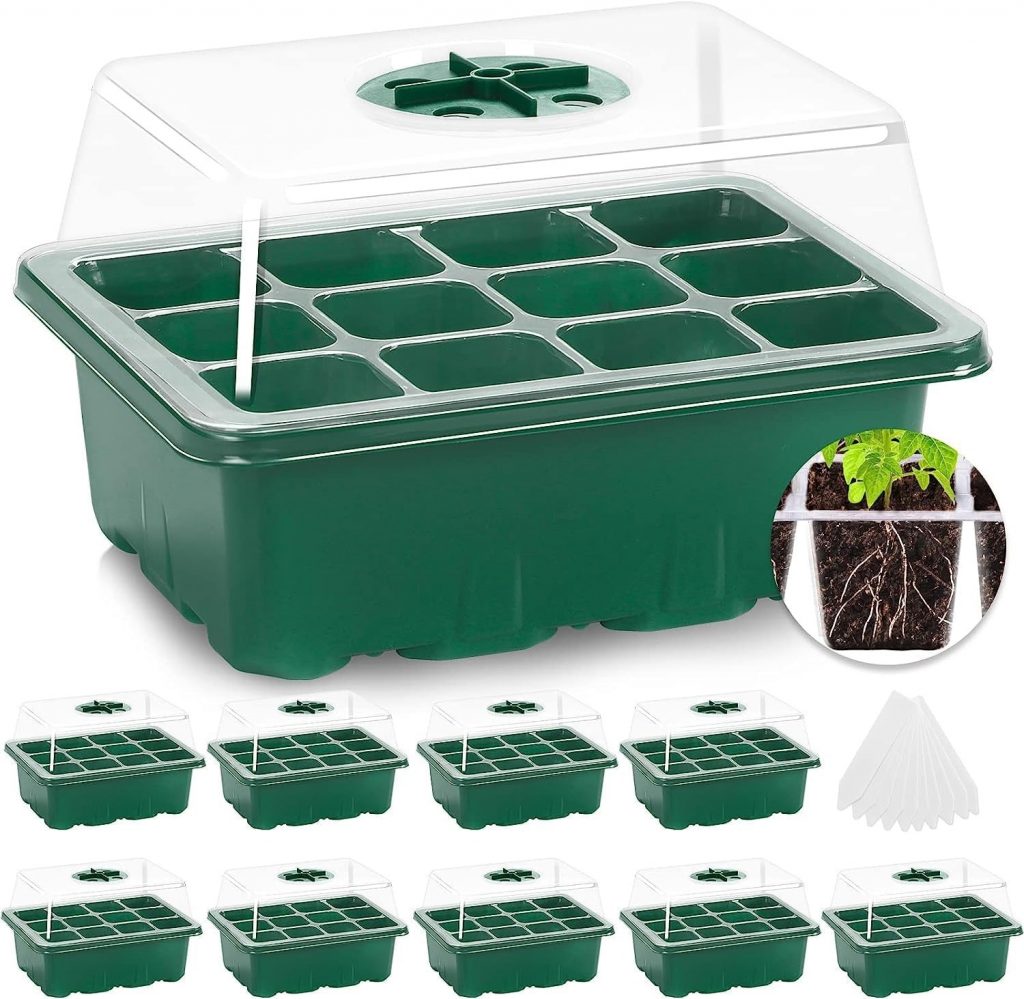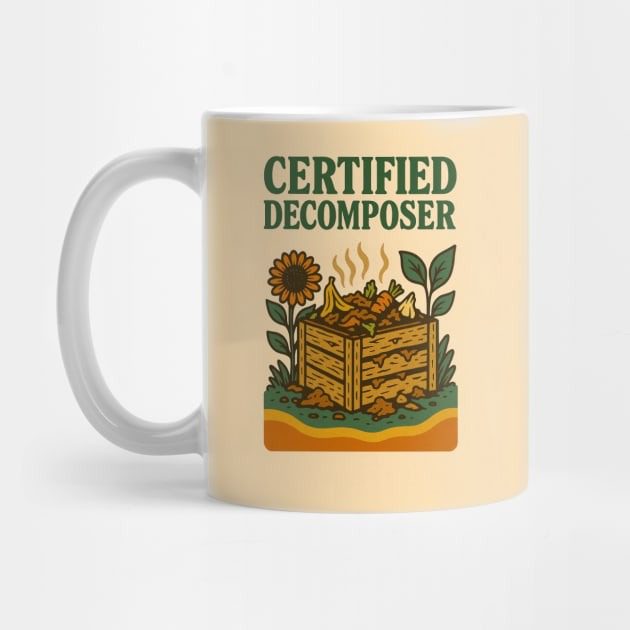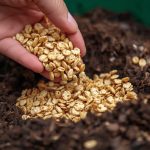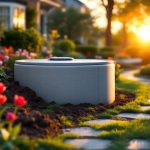Wondering what’s the best compost for seedlings and propagation trays? The answer is a fine, well-balanced seed compost that holds moisture but still lets roots breathe.
Composting is all about recycling kitchen and garden waste to make nutrient-rich soil, which gives your baby plants the perfect start.
Using home-made compost, including vermicomposting or a compost tumbler, keeps your garden healthy, saves money, and supports a greener planet.
Smart composting not only means healthier seedlings but also shrinks your household waste.
Whether you’re new to it or already get a kick out of feeding your bins, this article will help you choose the right compost, understand why it matters, and give you easy tips for growing strong, happy plants from day one.
Key Takeaways
- The best compost for seedlings is light, rich, and drains well.
- Home composting reduces waste and supports healthy plant growth.
- Vermicomposting and compost tumblers are simple ways to make great compost.
- Anyone can compost at home and grow seedlings that thrive.
Ready to learn more?
This guide will help you pick the ideal compost, set up your trays, and start strong. For extra tips on starting composting, check out our external guides and resources to help you grow with confidence.
What is Composting and Why Does It Matter for Seedlings?
Composting is nature’s recycling system, turning kitchen scraps, garden waste, and even paper into rich, dark compost that plants love.
For anyone setting up seedlings or filling propagation trays, making your own compost is like cooking up a superfood smoothie—it packs nutrients, encourages strong roots, and helps delicate baby plants get a great start.
Whether you’re using a classic heap, trying vermicomposting with worms, or spinning a compost tumbler, your homemade mix can make all the difference between wimpy sprouts and flourishing seedlings.
But what is composting, and why should seedling growers care?
Let’s dig in.
 Photo by Sippakorn Yamkasikorn
Photo by Sippakorn Yamkasikorn
What is Composting? The Basics
Composting is the simple act of piling up stuff from your kitchen or garden—things like veggie peels, eggshells, lawn clippings, and fallen leaves—so that nature’s tiny helpers (bacteria, fungi, and sometimes worms) can break everything down into crumbly, dark material called compost.
This compost is packed with nutrients and helps soil hold water, making it healthier and easier for roots to grow.
There are a few common composting methods:
- Traditional compost bin or pile: Just layer your waste in a heap or bin, add air with a fork every week or two, and let the microbes get to work.
- Vermicomposting: Use special worms in a bin to turn scraps into a fine, rich compost (called worm castings) that’s especially gentle for seedlings.
- Compost tumbler: A sealed barrel you spin to mix compost quickly and keep pests out—a great choice for small spaces.
For a deep dive into different ways to start composting in your own home, see this beginner’s guide to starting composting at home.
Get this great pillowcase from our Teepublic Compost Collection TODAY
Why Composting Matters for Seedlings
The best compost for seedlings and propagation trays supports healthy, strong roots while feeding young plants just enough for steady growth. Here’s why that matters:
- Seedlings are sensitive. They need a compost that’s not too rich or heavy. Fast-growing roots want air, water, and gentle food—think of a nursery for newborns, not a junk food buffet.
- Compost holds moisture but drains excess water, giving seeds the just-right balance they need to sprout.
- Natural disease fighters. Well-made compost introduces good microbes to the soil, which can protect against diseases and strengthen new plants.
- Reduces household waste. Every banana peel or wilted lettuce leaf you compost is one less thing in the trash.
- Saves money. Instead of buying endless bags of soil, you make your own top-quality mix.
Get straight talk about using compost for seedlings—from when compost is “ready” to why it needs to be fully finished—by reading this hands-on guide to compost in seed starting mix.
How Does Compost Work in Propagation Trays?
Picture a seedling tray as a tiny apartment block for plants. Each cell holds a seed, its first roots, and a scoop of compost.
Here’s what compost does there:
- Boosts root health: Nutrients seep in slowly, so roots aren’t burned.
- Balances water: Good compost acts like a sponge, holding what’s needed and letting extra water drain away.
- Improves structure: Fine compost keeps the soil loose, so tender new roots can explore easily.
- Encourages strong growth: The gentle food in compost means young plants grow without being pushed too hard or stunted.
Seedlings started in the right compost are less likely to suffer from damping-off (a killer fungus). For easy DIY recipes, check out this guide on making a DIY organic seedling mix.
Types of Composting for Every Gardener
Some gardeners swear by vermicomposting, especially if making compost indoors or on balconies.
Others love the ease of a compost tumbler—just pop in scraps, give it a spin, and wait for earthy gold in a few weeks.
If you want year-round composting success, check out monthly tricks in the composting calendar tips.
Key Takeaways
Here are the must-know points about composting and why it’s a star for seedlings:
- Composting makes rich, crumbly material that boosts seedling health.
- Best compost for seedlings and propagation trays is light, fine, and holds moisture.
- Vermicomposting and compost tumblers suit gardeners with any size space.
- Using compost at home is easy and free—plus, it helps nature recycle.
Starting your seedlings with the right compost sets you up for strong, happy plants. If you ever get stuck or want quick composting advice, the Ask A Question tool is always ready to help.
Propogators like the one below are crazy cheap..check them out TODAY
How to Choose the Best Compost for Seedlings and Propagation Trays
Selecting the best compost for seedlings and propagation trays means giving your young plants a stable foundation.
Good compost should offer plenty of nutrients, drain easily, and stay light so roots can grow fast and strong.
Whether you’re growing tomatoes on a sunny windowsill or filling a greenhouse with trays, this section covers practical tips that anyone can follow.
Seed Compost vs. Multipurpose Compost: Which is Better for Trays?
 Photo by Greta Hoffman
Photo by Greta Hoffman
Not all composts are created equal when it comes to starting seeds. Here’s what you need to know:
- Seed compost is made specifically for sowing seeds. It’s fine-textured, low in nutrients, and drains quickly, so delicate roots don’t get overwhelmed.
- Multipurpose compost is designed for a range of uses—containers, raised beds, and more. It often contains more nutrients, larger bits, and can sometimes compact or hold too much water in trays designed for seedlings.
For starting trays, seed compost wins most of the time.
Why? Seedlings have tiny, tender roots that crave gentleness—not too much food, not too much moisture.
Multipurpose compost can be too rough or nutrient-rich and may stunt seedling growth.
For a deep comparison and advice on choosing the right mix, you can check out the JamieSon Brothers seed compost guide for expert tips on choosing compost for seed trays.
How to Prepare and Use Compost Safely
If you’re using homemade compost (or even a bag from the store), it pays to get it ready before filling your trays. Clean, sifted compost is safer and gives seedlings the best start.
Follow these simple steps for safe, successful sowing:
- Sift your compost. Use a garden sieve or mesh to remove sticks, stones, and lumpy bits. This keeps the mix light and lets roots grow freely.
- Check for pests and weeds. Look carefully as you sift. Remove any insects, larvae, or weed seeds you find.
- Moisten before use. Compost should feel damp like a wrung-out sponge—never soaking wet.
- Mix in some perlite or vermiculite. If you want, a small handful adds fluffiness and helps drainage.
- Avoid soggy mixes. Wet compost can suffocate seeds and cause fungus. Always add water slowly and stir well.
Want to make the job easier?
Try building your own sifter for free with items from home—find a handy DIY compost sifter project with clear instructions to build your own compost sifter.
Signs of Good and Bad Compost for Seedlings
It’s easy to spot whether your compost will help or hurt your seedlings if you know what to look and feel for.
Here’s how to do a quick “compost health check”:
Good compost for seedlings:
- Smells fresh, like a woodland floor.
- Feels slightly springy in your hand, not sticky or dusty.
- Crumbles easily and is free of sticks or unrotted pieces.
- Looks dark brown or black, no signs of mold.
Bad compost for seedlings:
- Smells sour, rotten, or like ammonia.
- Is soggy, sticky, or clumps into hard balls.
- Has lots of insects, eggs, or worms crawling around.
- Contains obvious trash, plastic pieces, or big unbroken twigs.
Quick visual and feel tests:
- Grab a handful and squeeze. It should hold together but break apart with a tap.
- Look for even texture—no big chunks.
- If it stays wet for hours after watering, it may be too dense for seedlings.
If your compost doesn’t pass these checks, set it aside or add it to garden beds instead. Want more troubleshooting help?
If you’re stuck, try the Ask A Question tool for instant composting advice.
Key Takeaways
- The best compost for seedlings and propagation trays is fine, crumbly, and free of pests and weeds.
- Always sift compost and moisten gently before use.
- Perform quick smell and texture checks to make sure your compost won’t harm young plants.
Choosing the right compost at the start makes it much easier to raise strong, healthy seedlings at home—whether you’re composting, using vermicomposting, or trying out a compost tumbler.
Practical Tips for Sowing Seeds in Propagation Trays
Growing strong, healthy seedlings starts with the best compost for seedlings and propagation trays, but good technique can be just as important.
Sowing seeds in propagation trays may look simple, yet a few careful steps and smart troubleshooting can save you from disappointment.
From handling soggy compost to keeping your bin active all year, these tips put you in control of every tray you start.
Troubleshooting Common Problems with Seedlings and Compost
 Photo by Nikolett Emmert
Photo by Nikolett Emmert
Seedlings can be fussy little things. Even with the best compost, trouble can pop up. Keep an eye out for these common seed-starting issues:
- Damping Off: If your seedlings suddenly fall over or rot at the stem, this is likely to blame. Damping off is a fungal problem triggered by soggy compost, poor airflow, or dirty trays.
- Use fresh, sterile trays and always sift compost to remove chunks.
- Water gently from below to avoid splashing soil on stems.
- Don’t crowd your seeds. Give them space and light air movement.
- Poor Germination: Sometimes seeds just don’t sprout well. Old seeds, dry compost, or compacted trays can slow things down.
- Use fresh, fine compost and check that it’s damp before sowing.
- Press compost down very lightly; avoid making it too dense.
- Cover trays with a dome or clear lid to keep humidity even until seeds pop up.
- Stunted Growth: Slow seedling growth often means the compost mix is too rich, too dry, or too heavy.
If you want more help with these issues or a quick check-up, these handy guides on common seed starting mistakes and seedling troubleshooting solutions offer extra problem-solving wisdom.
For detailed soil mix advice, see these potting soil and compost usage tips which cover everything from composting basics to soil safety in propagation trays.
Composting Year-Round for Better Seedling Mixes
Fresh compost is key to happy seedlings, but composting is not just a summer hobby.
Keeping your bin or compost tumbler going throughout the seasons means you’ll always have the best compost for seedlings and propagation trays on hand.
Tips for steady, year-round composting:
- Feed little and often. Add kitchen scraps or soft garden trimmings regularly (even in winter).
- Balance browns and greens. Layer food scraps (greens) with dry leaves, shredded paper, or straw (browns). It keeps your compost airy and less smelly.
- Turn your pile (or spin your tumbler!). This adds much-needed air, speeding up composting and preventing soggy patches.
- Cover your bin. Keeping off heavy rain helps maintain good moisture, so compost isn’t a swamp.
- Warm it up. In cold weather, insulate your bin with cardboard or old carpet. Compost worms in a sturdy bin can also keep things active for vermicomposting fans.
Seasons change, but composting goes on. For monthly jobs and timely reminders, the Composting Calendar Tips can be your go-to guide for “what to add this month” or “how to manage compost in a cold snap.”
It’s packed with ideas to keep your heap or tumbler lively.
For a broader overview, check out this seasonal composting guide for composting tricks that suit any weather—whether you’re using a classic heap, a compost tumbler, or experimenting with vermicomposting indoors.
Key Takeaways
- Keep compost for seedlings fine and clean; sift it before sowing.
- Tackle seedling problems head-on by watching moisture and air flow.
- Composting is a year-round project. Stable mixes start with active bins or tumblers, even in cold months.
- Use both green and brown materials, and turn your pile to add air.
- Stay ahead with a monthly routine by following expert composting calendars.
Sowing seeds in trays isn’t just about soil—it’s working with living materials. With a little care and smart composting, you’ll soon see those tiny green shoots standing tall and healthy.
Summary and Key Takeaways
Choosing the best compost for seedlings and propagation trays isn’t just for expert gardeners—anyone can do it with the right knowledge, a little effort, and a splash of curiosity.
Whether you’re making compost at home with your food scraps, diving into vermicomposting for a bit of nature’s magic, or spinning a compost tumbler in a tiny backyard, the results all point to stronger, healthier plants.
Let’s wrap up the essentials so you walk away with confidence about seedlings, composting, and setting yourself up for gardening success.
 Photo by Kelly
Photo by Kelly
What Makes the Best Compost for Seedlings and Propagation Trays?
- The best compost for seedlings and propagation trays is light and finely textured, with a balanced mix of nutrients. It should hold moisture but never drown delicate roots.
- Home composting, vermicomposting, and compost tumblers all offer fantastic ways to make seedling-friendly compost that’s free from harsh chemicals and full of life.
- Always sift your compost for seed trays, removing any big chunks or rough materials. This creates a gentle bed for seeds to sprout with ease.
- Mixing in perlite or vermiculite can improve airflow and drainage. That means happier seedlings and fewer soggy mishaps.
For those new to the topic, a comparison of composts for vegetable seed starting gives real-world insights on which blends truly boost seedling success.
Practical Advice for Everyday Gardeners
- Make composting a regular habit with kitchen scraps and yard waste. By turning waste into black gold, you not only help the planet but give your plants a perfect start.
- Don’t worry about having all the gear or making it perfect. Even a simple bin or a basic vermicomposting setup will reward you with lovely compost over time.
- Step up your compost game by learning about different effective composting methods, from tumblers and heaps to easy indoor worm bins. Trying new methods can turn a chore into a fun hobby.
- Not sure when your compost is ready? Healthy, finished compost will always smell earthy—not foul or sour. It should look dark and crumbly, ready to cradle your seedlings.
If you want to compare and experiment, this guide on which seed starting mix is best breaks down the top ingredients gardeners use and why each one matters.
What Have We Learned?
Here’s a straightforward roundup of the most important lessons from this guide:
- Light, fine compost fuels healthy seedling roots—skip heavy, packed mixes in your trays.
- Homemade compost is cost-effective and reduces waste. Whether you use a compost tumbler or try classic vermicomposting, your seedlings benefit.
- Sifting and prepping your compost pays off. Remove lumps for happy, even growth.
- Keep it moist—not wet. Think damp sponge, not swimming pool.
- Pair compost with good sowing practices. Hydrate before sowing and avoid packing trays too tightly.
By following these simple steps, you’ll set up the best compost for seedlings and propagation trays without the stress.
For more seasonal guidance on how to keep your compost heap or tumbler active year-round, the Composting Calendar Tips provide month-by-month ideas for never running out of great compost.
Key Takeaways
Here’s a handy list to remember as you get started with your next seed trays:
- Fine, crumbly compost is best for seed starting.
- Vermicomposting and compost tumblers create nutrient-rich mixes for propagation trays.
- Homemade compost means fewer chemicals and more control.
- Sift, moisten, and fill trays lightly for strong roots.
- Keep compost slightly damp for healthy seedlings.
- Learn and adjust. Everyone’s compost, climate, and seeds are different—a bit of experimenting pays off.
Still unsure about your compost or have a lingering question? Head over to the Compost Charm Ask A Question tool for quick, expert advice anytime you need it.
A little patience, a little curiosity, and your tray of green starts becomes a victory garden before you know it.
Composting help is always just a question away—happy growing!
Frequently Asked Questions (FAQ): The Best Compost for Seedlings and Propagation Trays
Choosing the best compost for seedlings and propagation trays can feel tricky at first.
Many gardeners, from beginners to seasoned green thumbs, have questions about what works best, how to mix and use compost, and how composting methods like vermicomposting or a compost tumbler can help.
This FAQ tackles the top queries so you can start your seeds with confidence and a smile.

Photo by Ylanite Koppens
What is the best compost for seedlings and propagation trays?
The best compost for seedlings and propagation trays is a light, fine-textured seed compost. It should be free of large chunks, hold moisture gently, and have low to moderate nutrients. T
his gives tender roots plenty of room to grow and prevents burning or stunting. Aim for a blend that feels springy when squeezed and crumbles easily, similar to rich chocolate cake.
If you’re making your own, use fully finished compost and consider mixing in a bit of vermiculite or perlite. This helps keep air in your mix and lets roots explore without hitting hard spots.
Can I use homemade compost for seed starting?
Yes, you can absolutely use homemade compost for seedlings, but with a few best practices:
- Sift compost to remove any twigs, stones, or tough bits.
- Check that it’s fully broken down and smells earthy (not sour or rotten).
- Mix with sand, perlite, or vermiculite for extra fluff and drainage.
Remember, while rich compost is great for mature plants, seedlings prefer a gentle start. For hands-on tips, this DIY organic seedling mix guide breaks down safe ingredients and mixing ratios.
What about compost from a worm bin (vermicomposting) or a compost tumbler?
Worm compost (also called castings) and compost from a tumbler are both excellent choices, but moderation is key.
Worm castings are packed with nutrients and beneficial microbes, so blend them with regular seed compost or coconut coir to avoid nutrient overload.
Compost tumbler material should be well-finished and sieved for the softest texture.
Interested in trying worm bins or tumblers? The 6 Effective Composting Methods article gives an overview of all the ways you can make compost at home, including cool options for small spaces or kids.
How moist should compost be for seed trays?
Seed-starting compost should be moist like a wrung-out sponge—not dry or dripping wet. Water lightly before sowing your seeds.
If you accidentally overwater, mix in a little drier compost or perlite and let trays air for a few hours before planting.
Will store-bought multipurpose compost work?
Multipurpose compost can be used if nothing else is at hand, but it’s best to sift it and mix with perlite or sand.
Seedlings don’t need heavy feeding at first and can be fussy about texture. Seed-specific compost or a homemade blend designed for starters works better for the healthiest roots.
Can I start seeds without compost at all?
Seeds will sprout in many soil-less mixes, like coconut coir or peat, but compost adds a gentle, long-lasting food source and helpful microbes that boost early growth.
Compost-free mixes might need earlier feeding and extra care for watering.
Key Takeaways from the FAQ
- Always aim for fine, crumbly compost for seedlings and propagation trays.
- Sift and blend homemade compost for a soft feel and even drainage.
- Use worm castings or compost tumbler material sparingly and mix well.
- Keep your compost just damp for sowing—not sopping wet.
- Compost helps reduce waste and gives your seedlings a strong start.
If you ever get stuck or need instant answers, give the Ask A Question Bot a try.
For more practical advice on setting up your own composting routine, see the full guide to starting composting at home.
For even more insights and tips, this collection of common seed starting questions and answers is a great way to expand your know-how and avoid common pitfalls.
Happy composting, and may your seedlings thrive!
Get this great Mug from our Teepublic Compost Collection!
Conclusion
Using the best compost for seedlings and propagation trays can make seed starting easier and more rewarding than you might expect.
A light, crumbly mix—whether crafted from homemade compost, enriched through vermicomposting, or finished in a compost tumbler—keeps young roots happy and your garden off to a healthy start.
Composting not only boosts your plants but also helps cut waste, saves money, and supports a greener lifestyle.
Jump into composting with confidence! You don’t need fancy equipment to begin. Grab veggie scraps, start a simple bin, or learn new tips with the How to Start Composting guide—it’s that easy. Every small step makes your garden more sustainable.
For creative ideas and ways to turn food waste into plant food, the Don’t Toss It Tips are packed with clever solutions. Sustainable gardening is truly within everyone’s reach.
Key Takeaways:
- The best compost for seedlings and propagation trays is fine, soft, and holds gentle moisture.
- Sifting homemade compost or using worm castings creates a healthy foundation for seeds.
- Composting, vermicomposting, and compost tumblers provide simple paths to fresh soil.
- Composting at home can be fun, practical, and great for the planet.
- Trying composting is easy and anyone can get started, regardless of space or experience.
Ready to watch your seedlings thrive? Give composting a go and see just how simple growing green can be!
Thank you for reading, and feel free to share your best tips or composting wins with your friends and family. Happy gardening!
